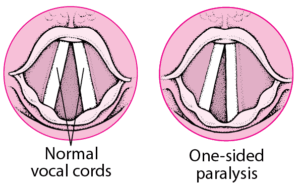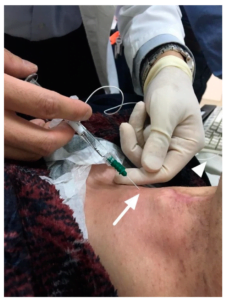Vocal Cord Palsy
Home | Voice, Throat & Swallowing | Vocal Cord Palsy
What Is Vocal Cord Palsy?
 Vocal cord palsy, also known as vocal cord paralysis, is a voice disorder that occurs when one or both of the vocal cords do not open or close properly. Vocal cord paralysis is a common disorder, and symptoms can range from mild to life threatening.
Vocal cord palsy, also known as vocal cord paralysis, is a voice disorder that occurs when one or both of the vocal cords do not open or close properly. Vocal cord paralysis is a common disorder, and symptoms can range from mild to life threatening.
The vocal cords are two elastic bands of muscle tissue located in the larynx (voice box) directly above the trachea (windpipe). The vocal cords produce voice when air held in the lungs is released and passed through the closed vocal cords, causing them to vibrate. When a person is not speaking, the vocal cords remain apart to allow the person to breathe.
A patient who has vocal cord paralysis often has difficulty swallowing and coughing because food or liquids slip into the windpipe and lungs. This happens because the paralyzed cord or cords remain open, leaving the airway passage and the lungs unprotected.
What Are Some Vocal Cord Palsy Causes? What Causes Vocal Cord Palsy?
There are numerous causes of vocal cord palsy, which include:
- Head trauma
- Stroke
- Neck injury
- Lung cancer
- Thyroid cancer
- A tumor pressing on a nerve
- Viral infections
In older people, vocal cord palsy is a common problem affecting voice production. People with certain neurologic conditions, such as multiple sclerosis or Parkinson’s disease, or people who have had a stroke may experience vocal cord palsy. In many cases, however, the cause is unknown.
What Are Some Vocal Cord Palsy Symptoms?
Symptoms of vocal cord paralysis include abnormal voice changes, changes in voice quality, and discomfort from vocal straining. For example, if only one vocal cord is damaged, the voice is usually hoarse or breathy.
Changes in voice quality, such as loss of volume or pitch, may also be noticeable. Damage to both vocal cords, causing bilateral vocal cord paralysis, although rare, usually causes people to have difficulty breathing because the air passage to the trachea is blocked.
How Is Vocal Cord Palsy Diagnosed?
 Diagnosis begins with a complete history of the voice problem and an evaluation of speaking method. A careful examination of the vocal cords will then be performed via nasoendoscopy.
Diagnosis begins with a complete history of the voice problem and an evaluation of speaking method. A careful examination of the vocal cords will then be performed via nasoendoscopy.
Sometimes, a second exam will follow a trial of voice rest to allow the ENT specialist an opportunity to assess changes in the vocal cord palsy. The patient may also be asked to perform dynamic speaking exercises to elicit whether the paralysis is partial or total.
What Are Some Vocal Cord Palsy Treatment Options?
 There are several methods for treating vocal cord palsy, among them surgery and voice therapy. In some cases, the voice returns without treatment during the first six months after damage. For that reason, doctors often delay permanent corrective surgery for at least six months to allow for spontaneous recovery. During this time, the suggested treatment is usually voice therapy and sometimes injecting the vocal cord with temporary bulking agents. Speech therapy may involve exercises to strengthen the vocal cords or improve breath control during speech.
There are several methods for treating vocal cord palsy, among them surgery and voice therapy. In some cases, the voice returns without treatment during the first six months after damage. For that reason, doctors often delay permanent corrective surgery for at least six months to allow for spontaneous recovery. During this time, the suggested treatment is usually voice therapy and sometimes injecting the vocal cord with temporary bulking agents. Speech therapy may involve exercises to strengthen the vocal cords or improve breath control during speech.
Surgery involves injecting bulk to the paralyzed vocal cord or changing its position. To add bulk, an otolaryngologist injects a substance, either temporary, or permanent, into the paralyzed vocal cord. This is done with a needle and syringe and does not require an incision. Other substances currently used are collagen, a structural protein; silicone, a synthetic material; and body fat. The added bulk reduces the space between the vocal cords so the nonparalyzed cord can make closer contact with the paralyzed cord and thus improve the voice.
Sometimes, a procedure called medialization laryngoplasty / thyroplasty is performed. This procedure permanently shifts a paralyzed cord closer to the center of the airway to improve voice and swallowing. This is done with a permanent implant through an incision in the neck using implants.
Treating people who have both vocal cords paralyzed may involve performing a surgical procedure called a tracheostomy to help breathing. In a tracheostomy, an incision is made in the front of the patient’s neck and a breathing tube (tracheostomy tube) is inserted through a hole, called a stoma, into the windpipe.
Is Vocal Cord Paralysis Curable?
The possibility of curing vocal cord paralysis is dependent on the underlying cause. If the underlying cause can be identified and addressed, there is a possibility of cure.

